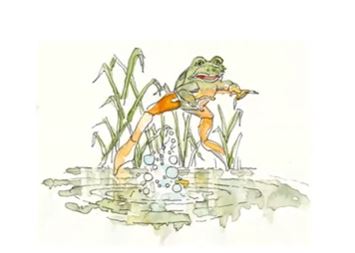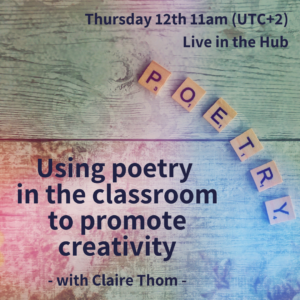It was really wonderful to be joined by Claire Thom, who is a very experienced ELT professional and author of Ever Forward. She’s from Scotland and currently works as a teacher in the south of Spain. Her book is a collection of fourteen haiku, with watercolour paintings by her dad, Colin Thom. All profits from the self-published book are going to the UK Guide Dogs association. Claire was also kind enough to share a handout with all the ideas shared in the session, including some ready-to-go worksheets.
She started the webinar with a little bit of background from Yasemin Kirkgöz, who defined creativity as ‘the ability to come up with new ideas that are surprising yet intelligible, and also valuable in some way.’ This led on to Claire saying that poetry is a personal activity and whilst we may try as much as possible to personalise coursebook and lesson content, working with poetry encourages them to view language, and the world, in a different way. She added as well that it’s easy to get bogged down, particularly in exam preparation classes, and creativity through poetry encourages a playfulness with language which it’s nice to return to. She later added that haiku can easily be graded to work with different levels.
What is a haiku?
Interestingly, the way we have adopted haiku in English is slightly different to the original Japanese: whilst we measure haiku in syllables, with a standard 5-7-5- pattern in the three-line poem, originally they were measured in sounds or ‘breaths’.
Claire highlighted how haiku often have a seasonal link and are about the natural world around us. She then went on to share a number of very practical ideas for working with haiku in the lessons. These are all outlined in the handout.

It was also wonderful to hear about the positive experiences of using poetry in the classroom: Claire mentioned how it can transport learners to a completely different world, especially if they’re given time to brainstorm the location and what they might see, hear, smell, touch and taste there. One Hub member also mentioned how using a restrictive task, such as limiting the number of syllables, really encourages learners to think about the words they use. Claire says that once students are familiar with haiku, they can easily be used as a warmer or end-of-the-lesson activity, and suggested creating a prompt bank of words chosen by students as a starting point; alternatively, you could give them an image as a starting point.
When Claire talked about doing a chain haiku, another Hub member commented that ‘collaboration changes the direction and forces the writer to bring it all together somehow. Really inspiring!’ Claire also mentioned how proud her teenagers were of the haiku they produced – despite orginally regarding the task with some suspicion. She had some wonderful ideas for ways that students can share their work too: Haiku Corner, a Haiku Poetry Slam or even publishing a collection of their work – all wonderful ideas to acknowledge their creativity.
She chose the title Ever Forward for her own anthology of haiku as it reflects the strength and determination that animals show of always moving forward and highlighted how in our classes we’ve become much more aware of nature and the climate crisis. Claire says that most students are very appreciative of the natural world and are keen on taking steps to improve the current situation.
One Hub member asked about working with different levels: Claire talked about working with a C2 group of adults, as well as working with B1 teens. Some of the feedback from the students was the¡at it allowed them to forget about everything else and just focus on the creative process. A lot of the activities, particularly the gapfill, could easily be adapted to working with lower levels or younger learners – and the fact that they are such short pieces of text means they hopefully won’t be overwhelmed by creating a piece of poetry. There was also a suggestion – to make the haiku a bit more TEFL-y – of using the haiku to work on pronunciation, perhaps y saying words must have a particular sounds or should rhyme.

What an excellent idea . Stimulating enthusiasm to play with words . Inspiring stuff !!!
I have started to use it with my students and the feedback has been joyous and positive .
Thank you .
Glad to hear you found the ideas useful, Jane 😃